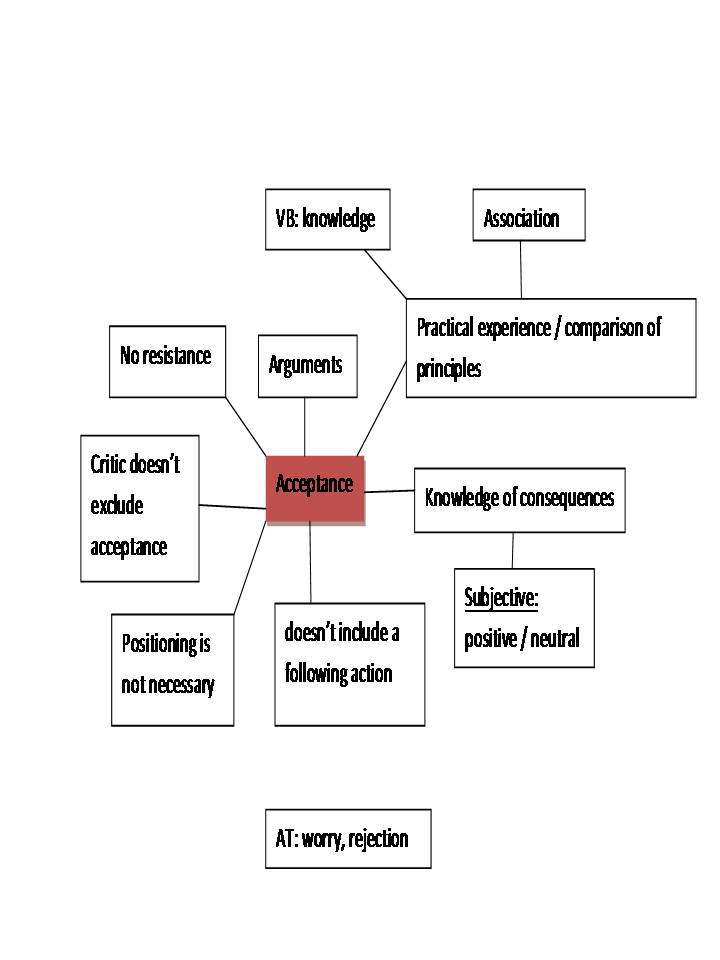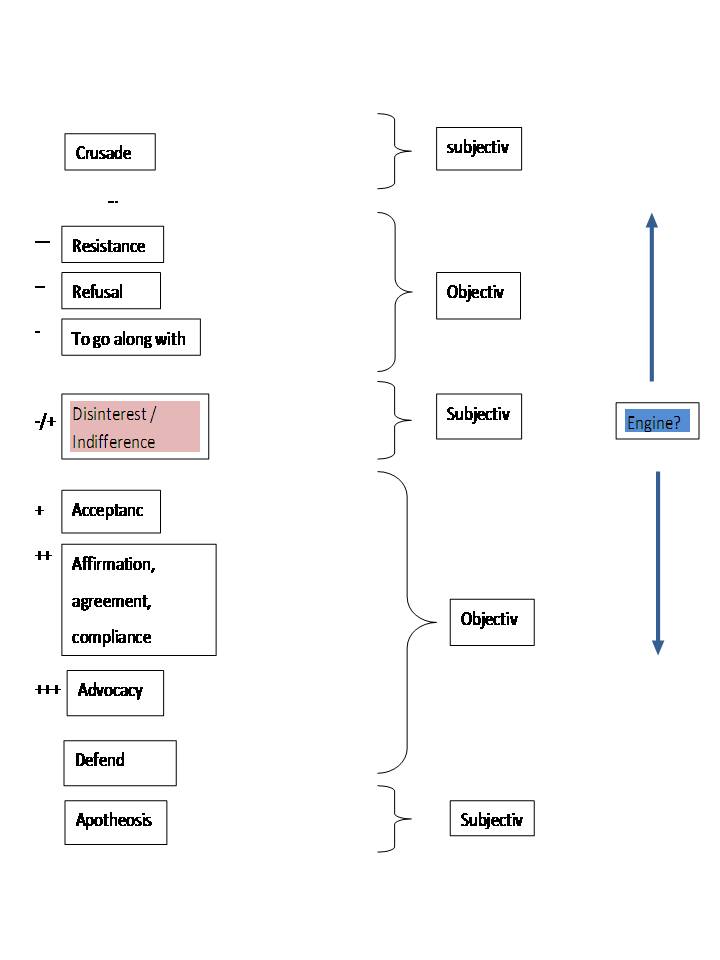Team:Heidelberg/Human Practices/Notebook/Psychology
From 2010.igem.org

Psychology NotebookThis notebook includes the important dates for both psychological parts: the construction of the questionnaire (SynBio-Questionnaire) and the psychological study (correlation between knowledge and acceptance). 31.03.2010After my decision of joining the iGEM team 2010, we had the first unofficial human practice team meeting with Marcus (the philosopher) and Dominik at the BioQuant-institute in Heidelberg. Dominik gave Marcus and me a short introduction into synthetic biology and together we discussed our expectations for the following project. 08.04.2010Our first official meeting with the human practice team (which consists at that time of Laura, Dominik, Phillip, Marcus, Jan and me). Marcus introduced our team into the basic methods of Philosophy and I told them something about Psychology and its usual procedure. Afterwards we talked about possible projects of the human practice this year. Referring the psychological part we thought for the first time of doing a psychological experiment or something like this. April until June 2010During April I considered different psychological projects as possibilities for a human practice. I looked at related scientific fields of synthetic biology like genetics or genetic engineering to get inspiration for my project. Considering genetic engineering, its negative perception here in Germany and the resulting scientific problems I got the idea of doing a psychological project studying the acceptance of synthetic biology. Focusing on that I made an extensive literature research during June looking for the answers of following questions: Are there studies about synthetic biology and its acceptance yet? Do studies exist of genetic engineering and its acceptance? What influences people’s acceptance of a new development? Are there qualitative good tools for measuring people’s acceptance? Unfortunately the literature research was not very successful: I have neither found studies measuring people’s acceptance referring synthetic biology nor a good instrument for measuring acceptance of a biological developement in general. Referring the main influence of people’s acceptance I found a big correlation to their knowledge. Based on this foundings I developed the idea of measuring people’ knowledge and their acceptance of synthetic biology. Furthermore I decided to create a good and methodically correct questionnaire for measuring acceptance of SynBio. 29.06.2010We had another human practice team meeting. I told the team about the theme of my psychological study and the two parts it exists of (1. construction of a questionnaire; 2. psychological experiment). Afterwards answering some questions we started working on the first part. I introduced my team members into the correct psychometrical steps of construction of a questionnaire:
06.07.2010Using the rational construction principle, the first step of construction a questionnaire was to specify our construct, we're going to measure. In general we decided to measure the attitude of our participants depending on their knowledge of Synthetic Biology. The knowledge will be manipulated during the study (so called “Happening”), so that we can use the finished questionnaire at the end to test their attitudes and acceptance referring SynBio. As an important condition for generating questions (Items) for the questionnaire, we decided to clarify our construct, the attitude of something. (acceptance is a positive attitude). For that we first made a literature research (What means attitude? What exactly means acceptance? Where is the difference?). As a second step we completed the research by doing an association cloud for acceptance. At least we generated the continuum of attitude with its implication of subjective and objective opinion making.
12.07.2010As homework, everybody of the Human Practice Team had to create as much as possible items referring the knowledge of Synthetic Biology and its acceptance, until this HP-meeting. During the meeting, we collected the Items and discussed every Item respective to its theoretical importance, formulation and similarity to other Items. For each Item we decided either to keep or to eliminate it. At the end we kept some Items to test the knowledge of SynBio, a pool of 40 items for the acceptance scale and 4 Items referring the application and perception of Synthetic Biology. These items were the base of the questionnaire perversion. 21.7.2010 – 28.07.2010We decided to create the preversion as an online version, so that the test can be distributed to a big amount of people in a little while. Before we could finish the preversion, we had to write an introduction of synthetic biology (the test-person of the online preversion doesn't know anything about synthetic biology, so they have to read the introduction before they can form their opinion about SynBio and answer the questionnaire). Besides of the introduction of SynBio we formulated a general introduction, invented a title of the questionnaire ("SynBio-Questionnaire") and added some items for descriptive statistics (age, sex, education, employment). Last but not least we checked the items and their fitting again (have every aspect been represented? Are there some double items? Do we have to reformulate the item into a negative or positive way?). In the end, we finished the preversion and created the online questionnaire. The link, where you could find the questionnaire was: https://www.soscisurvey.de/sinbio2010 Here you can see how the test-preversion looked. 01.08.2010 - 13.08.2010The execution of the questionnaire-preversion lasted 13 days. We distributed the link of our questionnaire via online-forums, university mailing lists and sent it to our friends and family. In the end we had 130 test-subjects, who filled in the questionnaire. 15.08.2010After collecting the data and download them from the internet the next step in the construction process was the statistical analysis. I used SPSS, a special statistic program. Within the statistical analysis I proved the reliability (its an important criterion for the wealth of a questionnaire and it shows, if the questionnaire measures its construct adequate), the characteristics of the items and the descriptive statistics (like age, sex, education and employment). This analysis was base of the following selection. From the 40 items of the preversion we selected only the 20 best with the best characteristics. These 20 items were the first part of the questionnaire endversion. 17.08.2010The second part of the endversion consists of the validity items. Validation is another important criterion for the wealth of a questionnaire. It shows if the questionnaire really measure what it is meant to measure (that mean if we are really measuring the acceptance toward synthetic biology). To create these items every member of the human practice team had the homework to think about constructs which are either
During the human practice team meeting we collected the ideas: attitude toward genetic engineering (convergent), intelligence (discriminant), attitude toward engineering (convergent), openness for values (convergent). Until the next meeting everybody should think which construct fitted the best as construct for our validation. 24.08.2010The first topic of this team meeting was the validation and the finishing of our questionnaire endversion. We talked about the different constructs and agreed in integrating the construct “openness for values” as a construct of convergent validity into the questionnaire. With this our questionnaire (SynBio-Questionnaire) was finished.
31.08.2010The next human practice team meeting. My team talked about organizational things like the room occupation plan for the happening, the catering, how many participants we want to recruit and some more things. Beside of this we created a first version of a notice for recruiting the participants. To improve the notice we decided to send them to our Weimar-art team (which has more experience in designing something). 02.10.2010Start of the recruiting of the participants. We recruited the test-subjects via a notice posted on campus and public offices, via an advertisement on a local newspaper and the local newspaper website and via personal contact. The recruiting lasted until the 15th of September 2010. 03.10.2010 – 16.10.2010During this two week we organized everything for the psychological study; we wrote the oral presentation and planed the practical part of the last group (movie). On the 10th of September 2010 we had a human practice meeting to summarize the intermediate result. 17.09.2010Final rehearsal. We proved if everything id ready for next day and if every team member knows what to do tomorrow. 18.09.2010The psychological study started at 2 pm. in the BioQuent-institute in Heidelberg. Altogether 71 participants took part. After every participant arrived I held a short introducing speech in front of the participants. Afterwards the first group was brought into another room, where they got the information paper and filled in the questionnaire. At the same time Marcus held the oral speech in front of the second and third group. After finishing the third group went into another room to watch the movie and the second group filled in the questionnaire. After watching the movie (which was commented by Phillip) and looking to soma things out of the laboratory (like PRC-machine) the third group filled in the questionnaire as well. Afterwards the Participants had the opportunity to eat some cake and drink a cup of coffee. The Happening ended at 5 pm. with a short explanation of the experiment and our methods we used. After the Happening everybody of the human practice team was really exhausted but happy! 22.09.2010 – 25.09.2010I spent the time to feed my computer with the data of the happening. Altogether I had to fill in about 5780 responses. 05.10.2010 – 07.10.2010I analyzed the data from the psychological study. I analyzed the descriptive statistics, significant effects of knowledge (is there a difference between the different level of knowledge considering their acceptance), validation and the items referring the application of synthetic biology. 11.10.2010 – 23.10.2010During this time I wrote down the results of the psychological human practice project. I wrote two separate papers, one about the construction of the questionnaire and the other about the psychological study. 24.10.2010I translated the material (like the oral speech), used during the psychological study (the study was in German and so I had to translate them). 25.10.2010I finished my notebook and presentation on the wiki. |
 "
"

